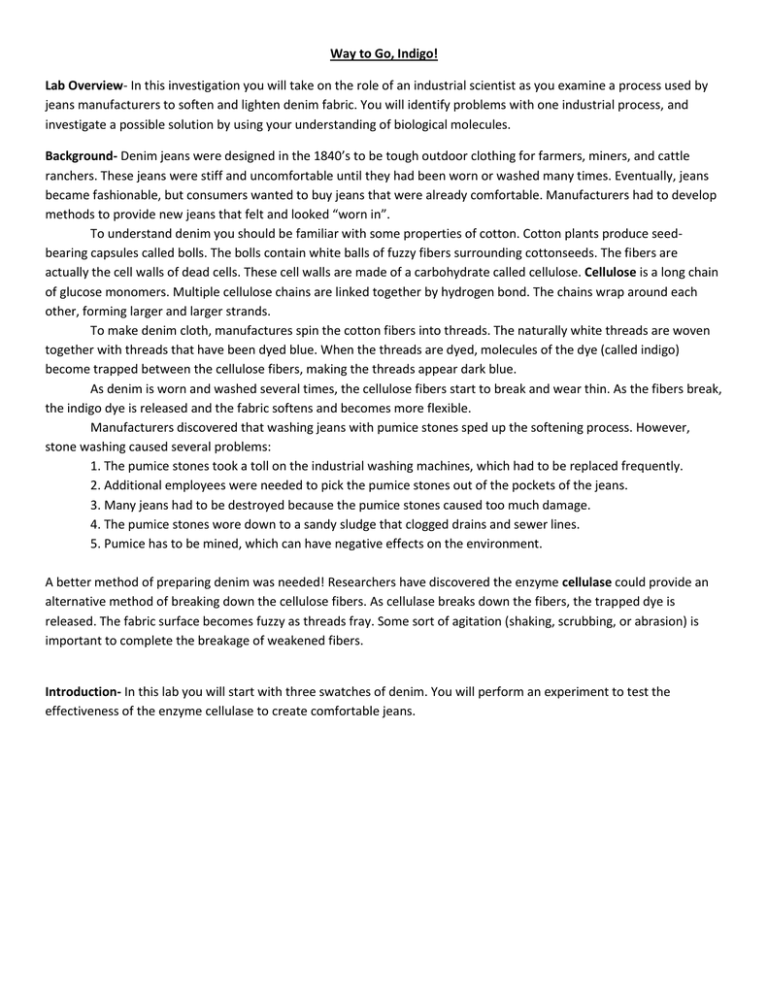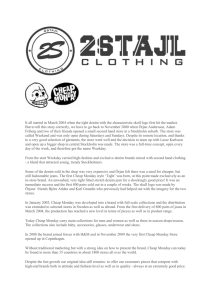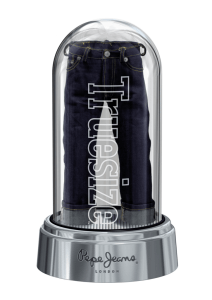Way to Go Indigo - Learning2 eSchool
advertisement

Way to Go, Indigo! Lab Overview- In this investigation you will take on the role of an industrial scientist as you examine a process used by jeans manufacturers to soften and lighten denim fabric. You will identify problems with one industrial process, and investigate a possible solution by using your understanding of biological molecules. Background- Denim jeans were designed in the 1840’s to be tough outdoor clothing for farmers, miners, and cattle ranchers. These jeans were stiff and uncomfortable until they had been worn or washed many times. Eventually, jeans became fashionable, but consumers wanted to buy jeans that were already comfortable. Manufacturers had to develop methods to provide new jeans that felt and looked “worn in”. To understand denim you should be familiar with some properties of cotton. Cotton plants produce seedbearing capsules called bolls. The bolls contain white balls of fuzzy fibers surrounding cottonseeds. The fibers are actually the cell walls of dead cells. These cell walls are made of a carbohydrate called cellulose. Cellulose is a long chain of glucose monomers. Multiple cellulose chains are linked together by hydrogen bond. The chains wrap around each other, forming larger and larger strands. To make denim cloth, manufactures spin the cotton fibers into threads. The naturally white threads are woven together with threads that have been dyed blue. When the threads are dyed, molecules of the dye (called indigo) become trapped between the cellulose fibers, making the threads appear dark blue. As denim is worn and washed several times, the cellulose fibers start to break and wear thin. As the fibers break, the indigo dye is released and the fabric softens and becomes more flexible. Manufacturers discovered that washing jeans with pumice stones sped up the softening process. However, stone washing caused several problems: 1. The pumice stones took a toll on the industrial washing machines, which had to be replaced frequently. 2. Additional employees were needed to pick the pumice stones out of the pockets of the jeans. 3. Many jeans had to be destroyed because the pumice stones caused too much damage. 4. The pumice stones wore down to a sandy sludge that clogged drains and sewer lines. 5. Pumice has to be mined, which can have negative effects on the environment. A better method of preparing denim was needed! Researchers have discovered the enzyme cellulase could provide an alternative method of breaking down the cellulose fibers. As cellulase breaks down the fibers, the trapped dye is released. The fabric surface becomes fuzzy as threads fray. Some sort of agitation (shaking, scrubbing, or abrasion) is important to complete the breakage of weakened fibers. Introduction- In this lab you will start with three swatches of denim. You will perform an experiment to test the effectiveness of the enzyme cellulase to create comfortable jeans. Pre-Lab Questions 1. Match each action of cellulase with its effect on denim fabric. a. softer textured denim b. more flexible, less stiff denim c. lighter colored denim ____As the strands of cellulose break apart, dye is released ____The fraying of the cellulose strands makes the cotton fibers in the thread fuzzy ____ The fraying of the cellulose strands reduces the thread’s strength and thickness. 2. Do you think that denim treated with cellulase for 1 hour would look or feel different than denim treated for 24 hours? Explain your answer. 3. The enzyme cellulase is produced by a type of fungus called a mold. Why might the denim industry be interested in determining the environmental conditions, such as temperature and pH, that are best for the growth of this mold? 4. What economic and environmental concerns do you think denim manufacturers might have about using enzymes to soften jeans instead of pumice stones? Data Table 1 Observations Color Texture Flexibility Experiment Swatch Control 1 Control 2 Analysis and Conclusions 1. Identify the independent and dependent variables from the experiment. 2. From the results of your experiment, would you say that cellulase treatment is an effective method for softening and lightening denim? Explain your response. 3. Explain the purpose of the control 1 swatch and the control 2 swatch in the experiment. 4. Write a conclusion for this experiment. (make sure you include all of the required parts) Some content from this lab was taken from: Campbell, Neil A., Brad Williamson, and Robin J. Heyden. "Investigative Lab 6."Biology: exploring life. Laboratory Manual ed. Needham, Mass.: Pearson :, 2004. 47- 51. Print.





